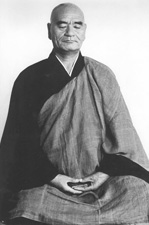Recent History
The recent history of the Tony’s lineage begins with a Japanese Soto priest named Kodo Sawaki (1880–1965). Sawaki-Roshi was an idiosyncratic, unorthodox priest and is considered by many to be something of a reformer. He downplayed the ceremonial aspects of priesthood and sought to bring Zen back to the essentials advocated by Dogen: the wholehearted practice of zazen and attention to everyday life. He did not see Zen practice to be something to be limited to the temples and monasteries, but encouraged lay people to practice seriously as well. He did not take up permanent residence in a temple until very late in his life, but moved about constantly, teaching and holding sesshins, and earning the nickname of "Homeless Kodo." A biography and portrait of this colorful master can be found in Living and Dying in Zazen, by Arthur Braverman.
The Sawaki lineage is best known in America through his disciple Kosho Uchiyama (1912–1998) and Uchiyama’s disciple Shohaku Okumura (1948–), a Zen priest and scholar who lives and teaches in Bloomington, Indiana.
Another of Sawaki’s disciples was Taisen Deshimaru (1914–1982), a businessman who became an exemplar of the serious lay practitioner. It is said that Sawaki refused to ordain Deshimaru as a monk but wanted him to practice as a layman. Deshimaru continued to live the lay life and practiced with Sawaki until the latter’s death in 1965. Just before his death, Kodo Sawaki finally gave Deshimaru monastic ordination and instructed him to take the practice of Zen to the fresh ground of the West. Deshimaru did so, emigrating to Paris, where he initially worked at a health-food store, gave massages, and began teaching the practice of Zen.
When he arrived in France, Deshimaru was not recognized as a teacher by the Soto Zen establishment. He was on his own and relied only on what had been transmitted to him by Kodo Sawaki. Deshimaru did not set out to replicate the temple system of Japanese Soto Zen Buddhism in France, but encouraged his followers to simply engage in serious lay practice, as he himself had done. In his dojo he retained many formal aspects of practice—ritual entry and exit of the dojo, bowing, the wearing of robes, kesa, rakusu. In the dojo he practiced and taught zazen, kinhin, and a simplified ceremony. He held regular sesshins and summer camps. Deshimaru proved to be a popular and charismatic teacher, and by the time of his death in 1982 he had ordained hundreds of monks, nuns, and lay practitioners and established practice centers throughout Europe. Eventually he was recognized in Japan, officially receiving the shiho from Reirin Yamada, the former head of Eiheiji temple. A short biography of Deshimaru is included in The Voice of the Valley, a book of his teachings edited by Philippe Coupey.
One of the monks that Deshimaru ordained was Robert Livingston (1933–2021), an American businessman and financier living in Paris. Livingston became one of Deshimaru’s close disciples, and after Deshimaru’s death in 1982 he moved to New Orleans, opened a dojo, and began teaching, using the form and style transmitted to him by Deshimaru. He established the New Orleans Zen Temple in 1992, served as abbot there until he retired from active teaching in 2016, and was succeeded by his dharma heir Richard Collins (1952–). Tony Bland (1946–) began practicing with Livingston in 1984, moved to Starkville, Mississippi, in 1994, and began teaching independently in 2004.



